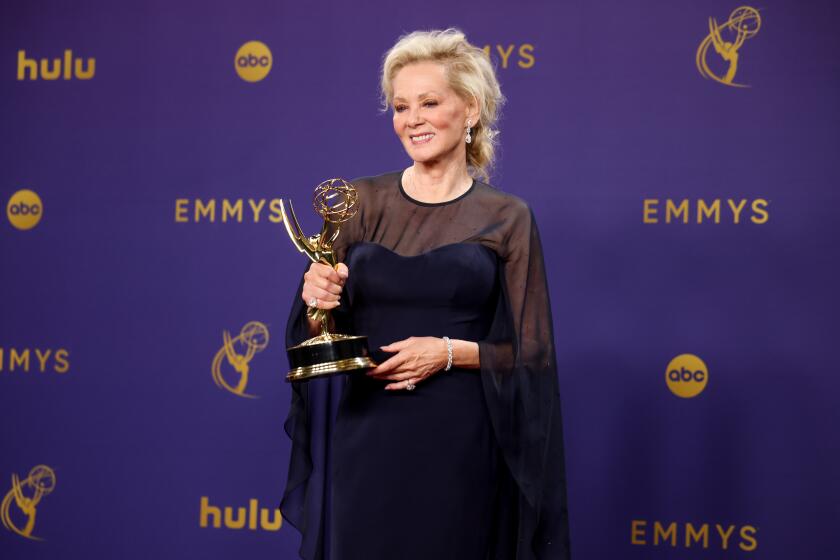Look inside why Coach Beard walks alone in that stray ‘Ted Lasso’ episode

- Share via
Technically, “Beard After Hours” wasn’t supposed to exist.
The bottle episode that divided fans and created critical applause appeared as Episode 9 in “Ted Lasso’s” second season and came at a critical narrative juncture: the Greyhounds had just lost a heartbreaking game to Manchester City, romances were being rekindled and team members were having an identity crisis. So where did the Emmy-winning series choose to go next?
By following a secondary character on a long, dark night of the soul, into a “Ted Lasso” sans Ted, sans virtually every other familiar face on the series, except for Coach Beard (Brendan Hunt). It was a bold move, but one that existed only because Apple TV was really, really proud of the series.
“We’d had a 10-episode season mapped out, and were breaking episodes when Season 1 debuted,” notes Hunt. “Ten days later, not only were we fully picked up for Season 2, but we were also picked up for two more episodes. So they had to be episodes that we hadn’t planned for.”
That’s how the Emmy-winning series’ second season ended up with a Boxing Day/Christmas episode and the hard left turn of “Beard After Hours,” written by Brett Goldstein and Joe Kelly. Goldstein, fans may note, is not just a writer and executive producer on the series … but also the actor who plays the foulmouthed Roy Kent.
Meet the cast, go behind the scenes on key episodes and read our analysis of the inspirational sports comedy that TV fans can’t stop talking about.
“We approached it with the device of ‘What would an episode of “Ted Lasso” be like if it was told from Coach Beard’s point of view?’” Goldstein writes in an email. “It’s why the theme tune and the look, tone and style of it [are different]. It’s a whole different vibe. Much darker and stranger. Because Beard’s brain isn’t as sunny as Ted’s.”
“Beard After Hours” is an episode many fans didn’t know they wanted until they got it. Beard has always been an enigma: quiet where Lasso is loquacious, an introvert when his coaching partner is all extrovert. But it gave the show a chance to prove that not every story had to use Lasso (Jason Sudeikis) as its hub, and present as more of an ensemble.
In the episode, Beard stoically takes the subway home from the crushing defeat, imagines the announcers on TV are chastising him directly and heads out into the night. What ensues is a mix of philosophy, romance, derring-do, a beating, lots of drinking and ripped trousers, sometimes with fans of the team, sometimes with strangers.
First-time “Lasso” director Sam Jones came on board for the stand-alone episode, and he says he was given “free rein” to make it look exactly as he wanted. (Jones had worked with Sudeikis on the 2013 music video for Mumford & Sons’ “Hopeless Wanderer,” where Sudeikis, Will Forte, Ed Helms and Jason Bateman played members of the band.)
“We didn’t want to use any of the normal locations or most of the cast,” says Jones. “[Sudeikis] really wanted to have a different feeling with this.”
Another difference to the episode was that Hunt didn’t get to see the script until it was nearly time to film. “I was excluded early on,” he said. “They didn’t come back to me until it was close to production, but by that time, I thought it was all above board. They were going to put me through [the wringer], but not f— with me.”
“We threw in everything,” says Goldstein. “Greek mythology, music, dancing, signs, threat, films, self-destruction, redemption and love.”
The episode is full of subtle call-backs starting with the title, an homage to Martin Scorsese’s 1985 film “After Hours,” itself an all-night journey into New York’s weird underworld. Jones says he used Wes Anderson for inspiration when it came to directing a show with no commercial breaks or B-story to provide natural cutaways; he notes that Anderson is deft at staying with one character for an extended period. Then there’s the “Clockwork Orange”-style slow-mo stroll down the street Beard and the fans take while wearing new duds. That shot was done for “Lasso” by the son of the camera operator who’d worked on 1971’s “Orange,” says Jones.
Yet it wasn’t a painless shoot, particularly for Hunt, who took a beating from all the running he had to do, a challenge for a man with “really high arches,” he says. “My orthotics were falling apart, and they had me run everywhere. I did not dance to my highest level.”
“It was a big load for one person,” allows Jones. “I was worried people wouldn’t accept it and say they wanted more Jason and storyline, but just the opposite. People love that it’s not a typical ‘Ted Lasso.’”
Arches aside, Hunt has been pleased with the results. “I’m OK with it, because it allows the audience to have a more full view of Beard, but not so full it interferes with any story we have going forward. It pries open his life — but not in front of any of the other characters.”
Still, Goldstein says if he could do it all again, he has some thoughts. “More dancing,” he says. “I will never tire of watching Brendan Hunt dance. It is pure, joyous wonder.”
More to Read
From the Oscars to the Emmys.
Get the Envelope newsletter for exclusive awards season coverage, behind-the-scenes stories from the Envelope podcast and columnist Glenn Whipp’s must-read analysis.
You may occasionally receive promotional content from the Los Angeles Times.






